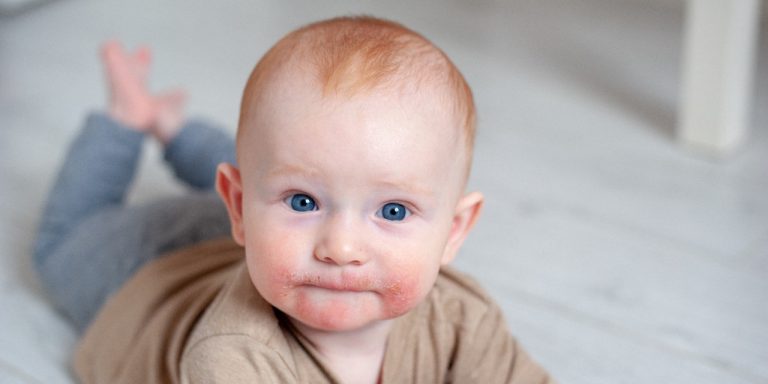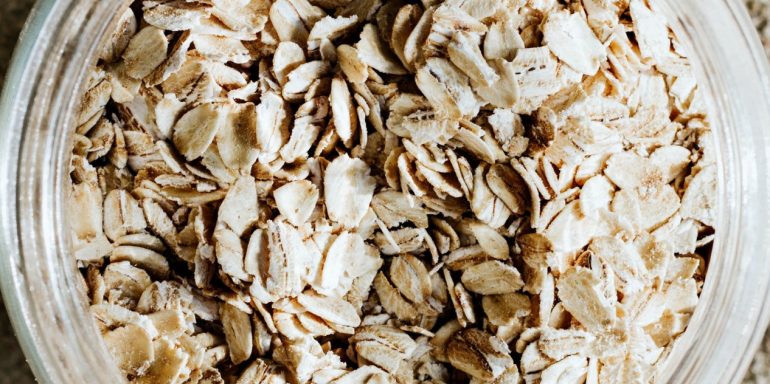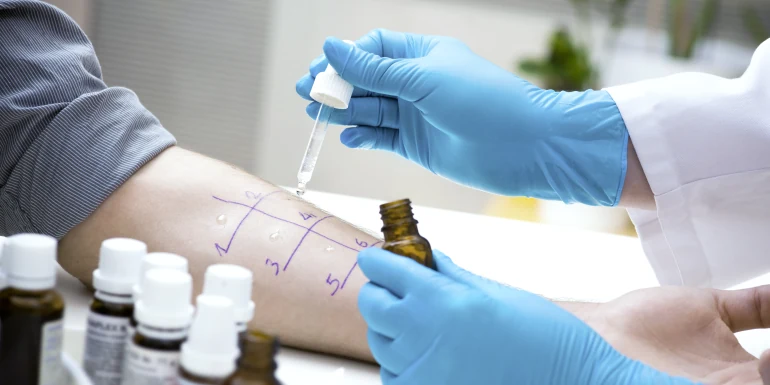
Neurodermatitis in babies: what can you do about it?
What does neurodermatitis in babies look like? How often should you bathe your baby? Can babies recover from neurodermatitis? Find out more about neurodermatitis in infants, and how it is treated.
Neurodermatitis in babies: what is it?
Neurodermatitis, which is also called atopic dermatitis or atopic eczema, is one of the most common skin conditions. It is chronic, and mainly affects babies and children. In cases of neurodermatitis, the skin is very dry, red, and sometimes even inflamed in places.
Between 15% and 30% of Swiss children suffer from neurodermatitis. The skin condition usually occurs during infancy or childhood, and disappears before adolescence in 70% of cases. However, not just babies, but also adults can suffer from neurodermatitis.
Neurodermatitis in babies is an atopic condition. If your baby is affected, its skin is overreacting to harmless environmental factors, as it also does in the case of allergies such as a pollen allergy However, neurodermatitis is not an allergy. It is a disorder of the skin barrier. Nevertheless, in babies, neurodermatitis often occurs in combination with certain allergies, such as a house dust mite allergy or a food allergy.
What causes neurodermatitis in babies?
There are a number of different potential causes of neurodermatitis in babies, and the condition often arises due to a combination of genetic factors and environmental influences. Babies whose parents suffer from neurodermatitis or allergies are at greater risk of developing the condition. Environmental factors include the climate, as well as chemicals such as certain detergents.
It is not always clear what external factors are causing neurodermatitis in your baby, and it may be a combination of several. The way the skin reacts to certain influences can also change over time.
What are the signs of neurodermatitis in babies?
There are a number of different signs of neurodermatitis in babies:
- Cradle cap: In newborn babies, neurodermatitis is associated with cradle cap. Cradle cap takes the form of yellowy-white crusts, usually on the scalp or cheeks. Although cradle cap is associated with neurodermatitis in babies, it can also occur separately and is usually harmless.
- Rash: Babies with neurodermatitis often develop a rash on their skin. In babies with neurodermatitis, this appears on their face, scalp, or the outsides of their arms and legs.
- Itching: Neurodermatitis in babies typically involves itchiness. This can be very severe, and lead to restlessness and problems sleeping.
- Dennie-Morgan lines: Characteristic lines under the lower eyelids may indicate a predisposition to neurodermatitis in infants. By themselves, however, they are not an adequate criterion.
- Flare-ups: Flare-ups are another symptom of neurodermatitis in babies. The severity of symptoms varies from flare-up to flare-up. Some phases will be more severe, while others will be milder or even complaint-free.
Please note: Neurodermatitis in newborn babies and children can disappear as they get older. Talk to a paediatrician or your GP if you think that your baby could be suffering from neurodermatitis. He or she will take a careful look at your baby’s skin and make a diagnosis. You will also be asked about allergies and neurodermatitis in your family. In order to make a reliable diagnosis, the doctor has to rule out other conditions such as psoriasis. Since the signs of neurodermatitis in babies are generally very clear, doctors usually recognise it quickly.
Neurodermatitis in infants: how can I prevent it?
Would you like to prevent your baby from developing neurodermatitis? Here’s what you can do:
- Smoke-free environment: Avoid tobacco smoke around your baby.
- Diet: You can slightly reduce your baby’s risk of developing neurodermatitis by changing their diet. Incorporate food that contains omega-3 fatty acids, such as fish or linseed oil, into their solid food.
- Skincare: Regular, gentle skincare reinforces the skin barrier and prevents dryness. You should ideally tailor the skincare products used to the seasonal conditions (i.e. heat or cold).
- Avoid stress: A calm, stress-free environment can reduce the risk that your baby’s neurodermatitis will flare up. Stress can cause outbreaks if your baby suffers from neurodermatitis.
The mother’s diet can affect the development of neurodermatitis in babies. Eat a balanced, varied diet during pregnancy. Avoiding allergenic foods such as eggs or cow’s milk before your baby is born has no effect on their risk of developing neurodermatitis.
In addition to diet, breastfeeding also plays a crucial part. Breastfeed your baby for the first four to six months of its life if you are able. If you don’t breastfeed your baby you should consult your paediatrician – particularly if neurodermatitis runs in your family. He or she will give you tips on how to feed your baby.
What helps against neurodermatitis in babies?
There are many different ways to treat neurodermatitis in babies:
- Shampoo: Among other things, neurodermatitis affects your baby’s scalp. If your baby suffers from the condition, you should therefore use a gentle baby shampoo. The aim is to gently treat the cradle cap without irritating the scalp.
- Evening primrose oil: It may be possible to treat neurodermatitis in babies using evening primrose oil. This would be a natural way to treat neurodermatitis in babies. A positive effect has at least been scientifically proven in small studies.
- Creams: There is no single cream that provides relief from neurodermatitis to every newborn baby. You should therefore consult your GP before using an ointment to treat neurodermatitis. Particular care should be taken if your baby develops neurodermatitis in the nappy area.
- Bathing: Bathe your baby for five minutes in lukewarm (not hot) water, two or three times a week. If your baby is suffering from neurodermatitis, add a medicated oil to its bathwater.
There are a number of different ways to treat neurodermatitis in babies. Consult your paediatrician or a dermatologist before you do anything. This is particularly important if you intend to treat your baby’s neurodermatitis using home remedies. You will get valuable information that will help you treat your newborn’s neurodermatitis.

This specialist provided the editorial team with expert advice and input for this article. Peter Schmid-Grendelmeier is head of the allergy department of the Dermatology Clinic at the University Hospital in Zurich. He specialises in allergies of all kinds, including neurodermatitis and urticaria (hives, nettle rash), tropical and travel dermatology and histamine-mediated diseases.


Newsletter
Find out more about current health issues every month and get all the information you need about our attractive offers from all Helsana Group companies * delivered by e-mail to read whenever it suits you. Our newsletter is free of charge and you can sign up here:
We did not receive your information. Please try again later.
* The Helsana Group comprises Helsana Insurance Company Ltd, Helsana Supplementary Insurances Ltd and Helsana Accidents Ltd.